Salt crust
Salt crust is the name given to the method of covering of an ingredient, commonly fish such as sea bass and grouper, in a sand-like mixture of usually egg whites and salt. The salt acts as insulation and helps cook the food in an even and gentle manner. After baking, the golden-brown shell is cracked, resulting in moist and evenly cooked food.[1] The technique is used often with chefs as it simultaneously roasts, steams and seasons.[2]
Food and techniques
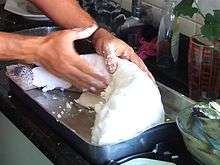
Traditionally fish is seen most commonly using the salt crust method to be baked but in recent times with salt becoming much cheaper and available than the past, has seen a rise in use in other areas. Usually temperatures of approximately 200º C are used in baking of the salt encrusted fish with the fish being flavoured and seasoned before being covered in the mixture of egg whites and salt.[3] The head and tail are left uncovered and is baked until the crust is golden brown. To serve, the crust is broken and the moistness should be preserved. Vegetables such as celeriac and beetroot are now being seen being baked in a salt crust as well. For beetroot, the stem and roots are cut off and then wrapped tightly in baking paper then covered in a salt crust completely sealed. Another non-traditional method is seen in the version of a pie with ramekins being used and a salt crust to cover the top.[4]
Beef Tenderloin baked with a salt-crust is a Colombian method for preparing beef tenderloin. The meat is crusted with salt then wrapped in a kitchen towel before being baked on a top of hot coals.[5] Another example is chicken being baked in a salt crust. There are variations on this dish such as instead of using salt the chicken is wrapped in lotus leaves or even clay is used. The underlying principle is the same, the chicken is baked in its own juices, preventing evaporation through the sealing of the crust.[6] For thousands of years, Sicily was supported by its salt lagoons as it was one of its important commodities. Baking fish in a salt crust is a popular method of cooking seafood over southern Italy. Fish native to the region such as bass, bream trout or snapper is traditionally used. A combination of coarse salt for the base and fine salt for the top is used as a crust with no egg being used as a binder.[7] Steak can also be cooked using a similar method rather than broiling it and risk the loss of its juices. Coating a pan with salt and cooking the steak, ideally approximately an inch thick or less, on top yields a more moist and flavourful cut. The pan is heated until the salt crackles and steaks cooked with this method usually involves a crispy crust made of the salt. This is a key difference to other salt crusts as usually it is discarded but in this case it is used to add texture and flavour to the steak.[8]
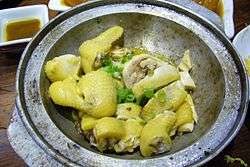
The technique of covering food in salt to create a sealed place is used by many cultures: Indian clay-pot cooking, French en papillote style and Oriental techniques which also emulate a sealed space. Oriental style uses instead of salt, wrapping food in plant matter such as leaves or bark.[8] The techniques all aim to lock in moisture and maximise the effect of the seasoning. Covering the ingredient in salt crust is the first part and the second part is baking it. Baking typically occurs in an oven and the fuel is supplied by wood, coal, gas, or electricity. The crust also acts as a mini-oven, locking the heat inside as salt is a poor conductor of heat creating an oven within an oven. This slows heat transfer to the food creating a slow and low dry oven, beneficial to most proteins.[9]
History
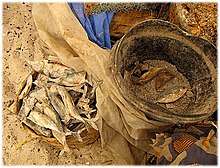
It is said that Egyptians were the first civilisation to utilise salt as a preservative in meat and fish. The earliest Chinese records show that the technique of preserving fish in salt goes back to 2000 B.C. whilst salted fish and bird meat was discovered in aboriginal Egyptian graves.[10] The salt-crusted fish has appeared in many different countries such as France, Italy, Spain and China. A huge amount of salt is needed to prepare the dish, and as such even a few hundred years ago it was very expensive, due to salt being a rare commodity in that time period. Earlier than that, the dish would have been reserved only for the wealthy and the prosperous.[11] Nowadays, it can easily be produced at home or in restaurants. By drizzling the crust in alcohol, restaurants burn the crust before being presented to the customer in flames.
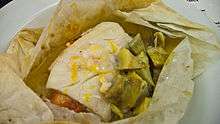
The first recorded reference in China resembling the technique of baking in a salt crust is Salt-Baked Chicken from Dong Jing in the province of Guangdong during the Qing Dynasty (1644-1911). The chicken was cooked and preserved in the salt fields of the area giving them added flavour. A more recent traditionally recipe is building a cocoon of salt around the chicken protecting it from direct heat ensuring even cooking and the possibility of drying out the meat. The chicken is wrapped in a tight parcel concentrating all the natural flavours of the chicken resulting in a succulent and tender product. This can be seen as the combination of the salt crust method with the French en papillote style.[12] In a Muslim cookbook originating from the thirteenth century, a layer of salt is placed on a new terracotta tile as a base and the fish is placed on top and another layer of salt is added on, then finally being placed in an oven. The Portuguese also have a history of drying and salting fish with their famous dish, Bacalhau, as before refrigeration, food needed to preserve to extend their expiry date. The fish used, cod, even caused battles between countries resulting in an Icelandic victory.[13] Callaloo was created by African slaves under Spanish rule sometime around 1530. Crab was originally used in the dish, but alternatives were found as the supply dwindled by the mid 1500s. Fresh fish was used by plantation owners as fertilizer but were then doused in salt to prevent slaves from eating the produce. Techniques such as boiling until the salt came off, soaking the fish until the salt was removed and even frying the fish in its salt crust were pioneered to tackle the problem.[14]
However, the earliest recipe found for salt-baked first comes from the fourth century BCE in Archestratus' Life of Luxury. The recipe details for a whole, round white fish such as sea bass, snapper or sea bream that was cleaned then gutted. The fish is seasoned with thyme being inserted into the cavity of the fish prior to the salt crust encapsulating it in two pounds of salt glued together with water and egg whites. Without earlier documentation, the Ancient Greeks seem to be the first ones to pioneer this technique.[11]
Culture
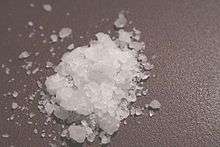
Salt is vital for life and has been valued by many different cultures and even more so for local Thai communities as it has been a source of income over generations. They showcase their salt producing heritage and their pride of it through a festival to commemorate and celebrate their history. The Art of Salt Festival lasts for three days offering attractions of sculptures, educational displays where birds, people and other animals are crafted out of salt. A dish which is popular among the locals is the salt crusted fish, stuffed with lemongrass and the salt crust protects the fish from drying out while its being grilled.[15]
In ancient times salt was used as part of religious offerings in Egypt and even for preparation of the afterlife. Funeral offerings of salt were given to Egyptian tombs out of consideration for the deceased as well as food such as salted birds and fish to be eaten in the afterlife. Salt was used in combination with natron in the desiccation process.[16] Salt was also used as a currency of trade between the Phoenicians and their surrounding empire of the Mediterranean. Researchers have suggested that even the Mayans salted their fish and meat to meet their dietary needs and to use it as a good which could be traded easily as it would be able to stored for longer times due to the preservative nature of salt.
In Japan salt is even considered sacred as they believe salt is cleansing and is often a defining flavour of Japanese dishes. It plays a major role in the making of dried fish and in the pickling of vegetables.[17] Turkey is also another important meat which old villages utilised the salt crust to not only to hold in all the juices but also so that the crust could be sealed and marked preventing tampering.[18] Chicken baked in a salt crust is a known traditional dish to the province of Hatay with records showing it was done as early in the Ottoman period. It is regarded that the Chinese applying the technique on the fowl has been transferred and adopted to Anatolia through migrations.
Research
A study conducted by the Sinop University in Turkey was done to determine the difference a salt crust makes on the rainbow trout (Oncorhynchus mykiss). The rainbow trout was prepared by first being gutted without being scaled with the head and tail being intact. Parsley and bay leaf were placed in succession with cuts of onion and lemon into an incision of the fish’s body, sealed with aluminium foil. This was done to prevent the absorption of salt into the actual flesh of the rainbow trout. The salt crust was made by a combination of rock salt, egg whites and water. The covered fish was baked at 180C for 45 minutes or until golden brown. The fish was allowed to cool down to room temperature and then the outer layer was broken using a knife.[10]
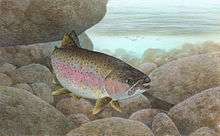
The salt content was calculated according to the Mohr Method defined by Dr Deniz Korkmaz, "where alkaline or alkaline earth chlorides such as sodium chloride (table salt) react with silver nitrate in the presence of a few drops of potassium chromate solution as indicator is a simple, direct and accurate method for chloride determination."[19] Other components such as crude protein, lipids and ash were done by AOAC: Official Methods of Analysis, 1980.
The results show that moisture (70.33% down to 62.45%) and carbohydrate levels (5.56% down to 1.42%) decreased while all the other values increased. Analysis from a statistical viewpoint shows that the salt and carbohydrate values were not found to be significantly different (P>0.05) however the other values were found to be significantly different (P>0.05). Sensory testing was however not done but the flavour was tested by trained professionals who concluded that the baking of the fish in a salt crust was satisfactory in terms of sensory characteristics. Some of the trained panelists added more salt to the dish. Hence it can be deduced that the dish can be readily eaten by people who suffer from various illnesses like hypertension.[10]
Bibliography
- Arhne et al. (2007) Effect of crust temperature and water content on acrylamide formation during baking of white bread: Steam and falling temperature baking. Food Science and Technology 40(10) 1708-1715 doi.org/10.1016/j.lwt.2007.01.010
- Martin James (2007) "Salt-crusted Sea Bass with runner bean salad"
- Dimbleby H., and Baxter J. (2015) "A Sicilian feast with salt-crusted seabass". The Guardian.
References
- Mitarai, Kumiko (April 12, 2010). "How to Bake in a Salt Crust". www.seriouseats.com. Retrieved 2018-10-20.
- "Salt-baking vegetables: Is it worth it?". Washington Post. Retrieved 2018-11-09.
- "Video Recipe: Salt-Crusted Fish - Video Recipe - FineCooking". FineCooking. Retrieved 2018-10-20.
- "Before #saltbae there was salt-crust". Food. Retrieved 2018-10-20.
- John, Chef (2016-12-09). "Salt-Crusted Beef Tenderloin – No Lomo". Food Wishes Video Recipes. Retrieved 2018-11-09.
- "Chicken baked in a salt crust". Food. Retrieved 2018-11-09.
- "Fish in a Salt Crust, Local Recipe in Sicily, Italy". www.summerinitaly.com. Retrieved 2018-11-09.
- Miller, Bryan. "GETTING THE MOST OUT OF MEAT BY COOKING IN SALT BED OR PASTRY". Retrieved 2018-11-09.
- McGee, Harold; McInerney, Jack; Harrus, Alain (1999). "The Virtual Cook: Modeling Heat Transfer in the Kitchen". Physics Today. 52 (11): 30–36. Bibcode:1999PhT....52k..30M. doi:10.1063/1.882728. ISSN 0031-9228.
- Kaba, N (2015). "A traditional food: 'fish baked in a salt crust'" (PDF). International Food Research Journal. 22 (2): 866–868 – via University of Sinop.
- "Culinary History Mysteries #1: Salt-Baked Fish – Silk Road Gourmet". www.silkroadgourmet.com. Retrieved 2018-10-20.
- "Salt Baked Chicken recipe (盐焗鸡) - The step-by-step guide". Taste Of Asian Food. 2018-08-07. Retrieved 2018-11-09.
- "From The Cod Wars to climate change: a salty story". Food. Retrieved 2018-11-09.
- "The Origins of 'slave food': Callaloo, Dumplings and Saltfish - Black History Month 2018 | Black History Month Celebrating the Great Black British Achievers". Black History Month 2018 | Black History Month Celebrating the Great Black British Achievers. Retrieved 2018-11-09.
- "Discover the amazing story of salt and its importance in Thai culinary culture - TAT Newsroom". TAT Newsroom. 2016-04-26. Retrieved 2018-10-20.
- "Salts in Ancient Egyptian Times". Sciencing. Retrieved 2018-11-09.
- "The Importance Of Salt In Japanese Culture And Cuisine - Kobe Jones". Kobe Jones. 2016-03-21. Retrieved 2018-10-20.
- "Salt-Encrusted Turkey Breast". Washington Post. Retrieved 2018-10-20.
- "Mohr method | Precipitation (Chemistry) | Titration". Scribd. Retrieved 2018-11-09.